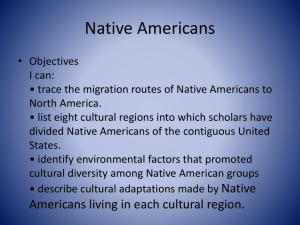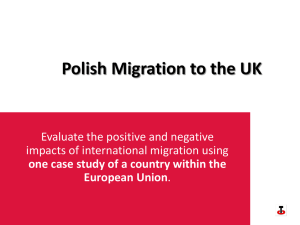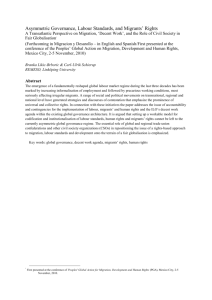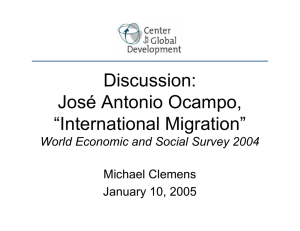RECENT TRENDS IN MEXICAN MIGRATION TO US: THE MEXICO PERSPECTIVE
advertisement
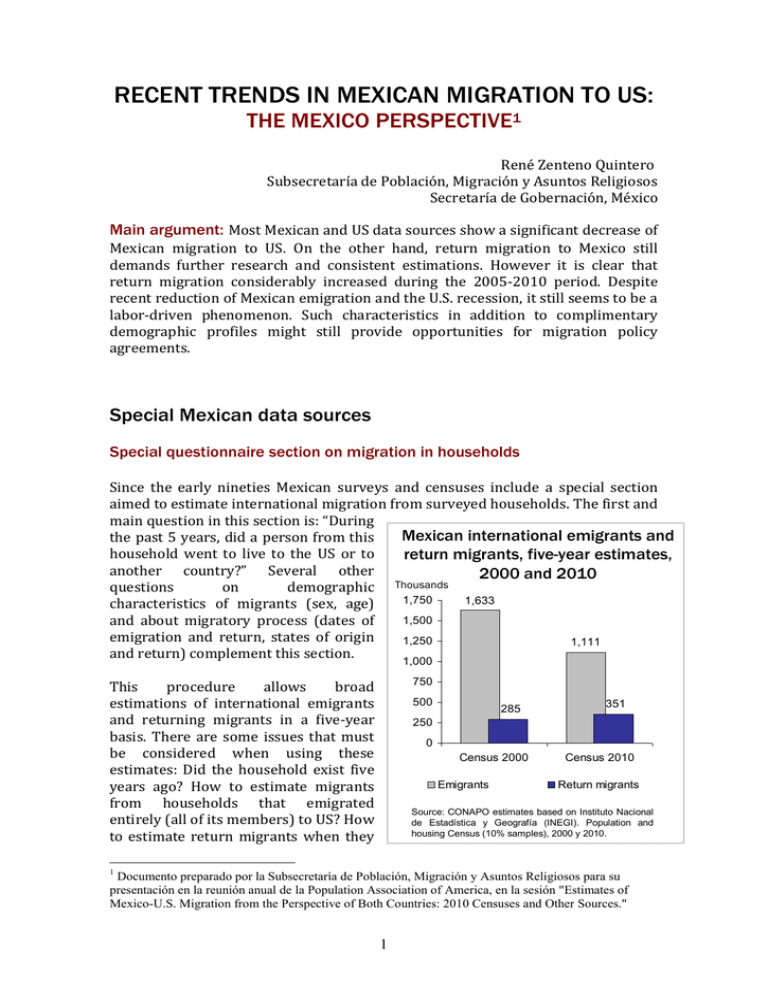
RECENT TRENDS IN MEXICAN MIGRATION TO US: THE MEXICO PERSPECTIVE1 René Zenteno Quintero Subsecretaría de Población, Migración y Asuntos Religiosos Secretaría de Gobernación, México Main argument: Most Mexican and US data sources show a significant decrease of Mexican migration to US. On the other hand, return migration to Mexico still demands further research and consistent estimations. However it is clear that return migration considerably increased during the 2005-2010 period. Despite recent reduction of Mexican emigration and the U.S. recession, it still seems to be a labor-driven phenomenon. Such characteristics in addition to complimentary demographic profiles might still provide opportunities for migration policy agreements. Special Mexican data sources Special questionnaire section on migration in households Since the early nineties Mexican surveys and censuses include a special section aimed to estimate international migration from surveyed households. The first and main question in this section is: “During Mexican international emigrants and the past 5 years, did a person from this household went to live to the US or to return migrants, five-year estimates, another country?” Several other 2000 and 2010 questions on demographic Thousands 1,750 1,633 characteristics of migrants (sex, age) 1,500 and about migratory process (dates of emigration and return, states of origin 1,250 1,111 and return) complement this section. 1,000 750 This procedure allows broad estimations of international emigrants and returning migrants in a five-year basis. There are some issues that must be considered when using these estimates: Did the household exist five years ago? How to estimate migrants from households that emigrated entirely (all of its members) to US? How to estimate return migrants when they 500 285 351 250 0 Census 2000 Emigrants Census 2010 Return migrants Source: CONAPO estimates based on Instituto Nacional de Estadística y Geografía (INEGI). Population and housing Census (10% samples), 2000 y 2010. 1 Documento preparado por la Subsecretaría de Población, Migración y Asuntos Religiosos para su presentación en la reunión anual de la Population Association of America, en la sesión "Estimates of Mexico-U.S. Migration from the Perspective of Both Countries: 2010 Censuses and Other Sources." 1 emigrated before the five-year period? Disregard data accuracy, a general trend can be established (but not exact levels): sharp decrease of Mexican emigration and an increase on the rate of return migration. In 2000 census: 1.633 million emigrants and 285 thousand returning migrants. For the 2010 census 1.111 million emigrants and 351 thousand return migrants. These estimates produce a limited proxy of annual net Mexican emigration: 269 thousand for 1995-2000 and 152 thousand for 2005-2010. Approximately, in both sources, close to 9 out of 10 migrants headed to and returned from US. In the years 1995-2000, only 17 percent of all migrants who migrated abroad had returned to Mexico in 2000. Ten years later, the percentage of return migrants almost doubled to 32 percent. According to the 2010 census data, less Mexicans are moving abroad and the chances of heading back to Mexico increased. Migration flows study with EMIF The Encuesta sobre Migración en la Frontera Norte de México (EMIF/Norte; Survey on Migration in the Northern Frontier) is a specialized survey on migration flows oriented towards labor characteristics. Interviews are conducted in the Mexican side of the border, near the border line, bus stations and meeting places of migrants (specific flows here presented do not capture individuals traveling by car or airplane, in this sense, estimates shown here represent flow of migrants with low socioeconomic status; other survey sections do capture high-status migrants). EMIF survey estimates flows in both directions. The flow heading towards US includes information of migrants who express their intention to cross over United States. The flow entering Mexico from the US includes information of migrants with permanent residence in Mexico as well as migrants that claim permanent residence in the US. In both directions, survey results are interpreted as “events” instead of “individuals”. The flow heading to US can be interpreted as “crossing attempts” or “events” because a migrant might be observed several times before succeeding in crossing the border, especially when counting passing individuals for the estimation of expansion factors. In the case of the flow entering Mexico an individual might also be observed several times (for example, in the border line and, again, in the bus station); however, in this case, a lower probability is expected for a migrant to stay long enough in the border area in order to be observed several times. Data for 2009 and 2010 is preliminary; figures for 2010 are still under revision. Panel data estimation with ENOE The Encuesta Nacional de Ocupación y Empleo (ENOE; National Survey of Occupation and Employment) reports quarterly estimations of Mexican emigration and immigration. The survey identifies total household members in an initial 2 quarter and, in the following quarters, reports missing members due to international migration and arriving members from abroad. Such procedure generates estimates of out, in and net migration. Some issues to be considered when using these estimates: How to recount multiple out and in events throughout a calendar year? How to estimate returning migrants when they do not return to old households but to brand new ones? The ENOE series report a sharp decrease of Mexican emigration rate during 20062008 but a somewhat stable immigration rate (with small fluctuations). Both trends produce a very small net international migration rate, even close to zero in some quarters. Of course, these estimates are controversial and subject to discussions and clarifications. Mexican in and out-migration rates, ENOE 2006-2010 Rates 16 14 12 10 8 6 4 2 2010/4 2010/3 2010/2 2010/1 2009/4 2009/3 2009/2 2009/1 2008/4 2008/3 2008/2 2008/1 2007/4 2007/3 2007/2 2007/1 2006/4 2006/3 2006/2 0 Year-Quarter Emigration Immigration Source: Instituto Nacional de Estadística y Geografía, Encuesta Nacional de Ocupación y Empleo (ENOE). As controversial as they might be, estimates of a remarkably reduced net Mexican migration do agree with some US figures. Namely, this small net emigration would imply little growth of the Mexican-born population in the US. The American Community Survey (ACS) and Current Population Survey (CPS) report estimates of the Mexican-born population. During 2003-2007 these estimates show a 1.6 million increase but recently, from 2007 and onwards, Mexican-born population seems to have halted its growth (it even shows a small decrease in the ACS series). 3 Mexican-born population in United States, 2003-2010 Millions 12.5 12.0 11.5 11.0 10.5 10.0 9.5 9.0 2003 2004 2005 2006 CPS 2007 2008 2009 2010 ACS Source: CONAPO estimates based on US Census Bureau, Current Population Survey (CPS), March Supplement 2003-2010; American Commmunity Survey (ACS), 2003-2009. However, migration movements continue Mexican emigration Despite the notable reduction of Mexican net migration, data sources in both countries still report numerous migration movements. For example, according to CPS series, between 1.5 million and 922 thousand Mexicans emigrated to US Mexican emigrants to US, five-year during 2005-2009. It is worth to estimates, by source and question remember that different questions, implemented, 2005-2009 included in the very same survey, Thousands systematically produce divergent 1,514 1,600 estimates for the same time periods. In 1,400 1,200 US sources, migration levels estimated 994 922 1,000 with the question of year of arrival are 800 always higher than the ones obtained 600 accumulating annual results from the 400 question about residence 1 year ago. In 200 Mexican sources, levels derived from the 0 section on migration in households are Five-year estimates 2005-2009 (complete years) somewhat similar to US lower estimates CPS 2010 (year of arrival during 2005-2009) (but never exactly the same). Different migrant profiles. Not only levels differ, also socioeconomic characteristics of same migration flows are not exactly the same according to US and Mexican sources. Usually, for the same time periods, US sources observe slightly older migrants than Mexican estimations 4 CPS 2006-2010 (accumulated residence 1 year ago, entrances 2005-2009) Mexican Census 2010 (Section for households, emigration to US during june 2005 to june 2010) Source: CONAPO estimates based on US Census Bureau; Current Population Survey 2006-2010 (CPS) and Instituto Nacional de Estadística Geografía (INEGI); Mexican census bureau 2010. and a higher proportion of women. Also migrants in US estimations have slightly higher educational levels and their geographic origins are situated, in a higher proportion, in urban areas. Such differences might indicate that US sources observe more long-term migrants than Mexican sources. Further research in this topic might prove fruitful. Mexican emigrants to US, five year-estimates, by age groups, sex ratio and source Age groups 65 and more Sex ratio 4 100% 1 80% 16 13 40 - 64 65 60% 21 20 30 - 39 40% 46 15 - 29 76 61 20% 13 0 - 14 35 5 24 0% 0% 15% 30% 45% 60% ACS average 2005-2009 (Residence 1 year ago) ENADID 2009 (Section for households) ACS average 2005-2009 (Res. 1 year ago) Female ENADID 2009 (Section for households) Male Source: CONAPO estimates based on US Census Bureau, American Commmunity Survey (ACS), 2005-2009; Instituto Nacional de Estadística Geografía, Encuesta Nacional de la Dinámica Demográfica (ENADID), 2009. Mexican geographic origins Mexican emigration has its origins in almost every state of the country. Nevertheless, Mexican 2010 Census data, with special section on migration in households, shows that almost half of total emigrants left from only six states: Guanajuato, Jalisco, Michoacán, Estado de México, Puebla and Veracruz. In recent years other states increased their share in the migration process. For example, the state of Oaxaca today contributes to the total number of migrants with 5 out of every 100. For almost all state estimations, approximately 9 out of 10 migrants headed to US. 5 Mexican emigrants by main states of origin, volume and distribution, 2000 and 2010 Thousands 300 Distribution 10.8 10% 250 7.7 8% 6.8 200 174 160 6.6 163 150 5.6 5.3 135 120 100 6% 4.5 3.9 86 85 76 70 73 3.7 3.1 87 79 63 73 56 59 50 50 61 60 43 41 4% 2.8 66 50 34 31 Census 2010 (Abs) Census 2000 (%) Zacatecas San Luis Postosí Hidalgo Guerrero Distrito Federal Oaxaca Veracruz Puebla Edo. México Michoacán Jalisco Guanajuato 0 Census 2000 (Abs) 2.7 30 Chihuahua 7.7 2% 0% Census 2010 (%) Source: CONAPO estimates based on Instituto Nacional de Estadística, Geografía (INEGI), Population and Housing Census (10% samples), 2000 y 2010. Flow of Mexican migrants heading towards US In recent years EMIF series report an important reduction in the number of attempts of border crossing. This flow almost halved it size between 2007 and 2010. Another significant change occurred in the same period regarding undocumented migration. While in 2006 and 2007, the flow consisted almost entirely of undocumented migrants (8 out of 10 crossing attempts were tried without any documents), in 2010 only half of the crossing attempts were performed by migrants without proper documents. The significant decrease of undocumented migration Furthermore, the reduction in the outmigration flow relates to a significant decrease of undocumented migration. In turn, the decrease could be related to new state laws and stronger border control but also, to the capacity of undocumented migrants to adjust their routes according to labor market conditions. In any case, it is still necessary to produce detailed research to derive unbiased explanations. 6 Flow of migrants heading towards U.S. by possession of migration documents, 2005-2010 Thousands 1,000 900 855 814 800 706 746 20% 18% 700 630 24% 600 33% 492 38% 500 400 52% 80% 81% 300 76% 67% 200 61% 48% 100 0 2005 2006 2007 2008 Undocumented 2009 2010 With migration documents Source: CONAPO estimates based on CONAPO, STPS, INM, SRE and COLEF, Encuesta sobre Migración en la Frontera Norte (EMIF NORTE), 2005-2010. Labor-driven migration. Reasons to cross to the US are slowly changing. However, most Mexican migrants still cross, as it has been historically, searching for better paid jobs. In recent years the proportion of crossing attempts performed because of labor related motives decreased; yet, most of the crossing attempts are still performed by migrants who wish to work in the US. Flow of migrants heading towards U.S. by motive for migration, 2005-2010 100% 90% 80% 70% 60% 50% 40% 30% 20% 10% 0% 5 4 5 15 12 16 80 2005 Work 83 79 2006 2007 11 7 6 19 22 30 70 71 2008 2009 Reunion with family or friends 63 2010 Other Source: CONAPO estimates based on CONAPO, STPS INM, SRE and COLEF, Encuesta sobre Migración en la Frontera Norte (EMIF NORTE), 2005-2010. Complementary populations Demographic complementarity of population stocks in US In terms of age-structure of population stocks, we can see that Mexican immigrant population in US accumulates in age groups where US labor force is relatively small. The bulk of the Mexican immigrant stock concentrates in ages between 25 to 44 years old, just in the same age groups where US-born population shows gaps. 7 Such coincidence can be found for both sexes. In terms of magnitude, there cannot be any possible competition given huge absolute differences; US-born population is more than 20 times bigger than Mexican-born (266 million versus 11.6 million, respectively). Demographic complementarity. Mexican immigrants accumulate in age groups where U.S. labor force is diminished Age 80 + 75 - 79 70 - 74 65 - 69 60 - 64 55 - 59 50 - 54 45 - 49 40 - 44 35 - 39 30 - 34 25 - 29 20 - 24 15 - 19 10-14 5-9 0-4 Males Females US-born US-born Mex-born 11 10 9 8 7 6 5 4 3 2 Mex-born 1 0 1 2 3 4 5 6 7 8 9 10 11 Millions Males US-born Males Mex-born Females US-born Female Mex-born Source: CONAPO estimates based on U.S. Census Bureau , American Community Survey, 2009. US geographic destinations Today Mexican-born immigrants live in nearly all of the United States territory, including Alaska and the associate state of Puerto Rico. Despite this fact, Mexicanborn population still concentrates in the southwest states (California, Arizona, and Texas). Also, Florida, Georgia and North Carolina gained participation as settling destinations. 50% 40% Mexican foreign born immigrants in US by state of residence, 2000 and 2009 42.1 37.5 30% 20.9 20.8 1.6 2.4 1.7 2.4 2.2 2.1 2.0 2.1 2.2 2.0 1.6 1.9 Colorado New York Nevada 5.6 5.1 North Carolina 6.2 6.0 Georgia 10% Florida 20% Arizona Illinois Texas California 0% ACS 2000 ACS 2009 Source: CONAPO estimates based on U.S. Bureau of the Census, American Community Survey 2000 and 2009. 8 Immigration and return migration to Mexico Mexican return migration from US Immigration and return migration to Mexico does occur. Nonetheless, US sources do not estimate Mexican return migration. In addition to the special section on migration in households, Mexican censuses and surveys also include internationally comparable questions aimed to observe immigration, as Place of residence 5 years ago. Older data sources included the question about Length of stay in actual residence (however, this question was not included in recent sources). The last edition of the Encuesta de la Dinamica Demografica (ENADID, National Survey of Demographic Dynamics) included a question about Place of residence 1 year ago. However, return migration to Mexico seems to be a very complex phenomenon. Estimates from different instruments (questions) are completely different in terms of levels and trends. Strikingly dissimilar estimations of return migration arise from two different instruments. Results derived from the question about residence 5 years ago show an unmistakable trend of sharp increase in return migration. In 2010 census return migrants reached an historical high level close to 1 million. On the other hand, estimates derived from the special section on migration in household present no clear trend and no relation at all with other return estimates (however this results might be related to emigration levels reported by the same section). Return migrants to Mexico, five-year estimates from two different questions implemented in the same data sources 994 951 717 643 461 388 351 Census 2010 Census 2000 ENADID 2009 267 261 ENE 2002 289 344 ENADID 1997 291 Conteo 1995 ENADID 1992 Thousands 1,000 875 900 800 700 600 500 400 300 180 200 100 Derived from question of residence 5 years ago Derived from section on migration in households Source: CONAPO estimates based on Instituto Nacional de Estadistica y Geografia, Encuesta General de Dinámica Demográfica (ENADID) 1992, 1997 y 2009, Conteo de Población y Vivienda 1995, Encuesta Nacional de Empleo (ENE) 2002, Censo General de Población y Vivienda, 2000. Mexican returning destinations As in the case of Mexican emigration origin states almost every state of the country has returning migrants. Mexican 2010 Census data, with special section on 9 migration in households, shows that most than half of total returns goes to seven sates: Jalisco, Guanajuato Estado de México, Michoacán, Veracruz, Distrito Federal and Puebla. Almost 9 out of 10 migrants, in these figures, returned from US. Mexican return migrants by main states of residence, volume and distribution, five year estimates, 2000 and 2010 Thousands Distribution 70 12% 60 9.9 9.8 10% 8.8 50 7.4 34 31 26 5.8 32 5.3 5.3 6% 26 24 20 20 19 19 18 10 3.0 10 8 10 3.6 13 Censo de 2000 (Abs) Censo de 2010 (Abs) Hidalgo Puebla Distrito Federal Veracruz Michoacán Edo. México Jalisco Guanajuato 0 11 11 Censo de 2000 (%) 3.0 13 10 2.8 8 4% 2.7 10 10 2% 5 0% Oaxaca 30 8% San Luis Potosí 35 Zacatecas 37 Chihuahua 40 Censo de 2010 (%) Source: CONAPO estimates based on Instituto Nacional de Estadística, Geografía (INEGI), Population and Housing Census (10% samples), 2000 y 2010. State return proportions of Mexican migrants, for main states of return (section for households), 2000 and 2010 50% 41 41 37 35 33 32 31 30 29 30% 20% 22 25 22 18 20 17 22 19 16 13 13 16 11 Census 2000 Puebla Guanajuato San Luis Potosí Michoacán Hidalgo Veracruz Zacatecas Distrito Federal Jalisco Edo. México 0% Chihuahua 10% 9 10 Oaxaca 21 29 Guerrero 40% Census 2010 Source: CONAPO estimates based on Instituto Nacional de Estadística, Geografía (INEGI). Population and Housing Census (10% samples), 2000 and 2010. Results from the question residence five years ago display a different scene than returning migration from section on migration in households. Immigrants aged five years or over trace notable differences in volume and relative share of some states. 10 Mexican immigrants aged five years or over by state of residence, 2000 and 2010 (question on residence five years ago) Distribution Thousands 14% 180 160 12% 140 10% 9.4 8.3 120 7.6 5.5 63 6% 58 4.1 46 4.0 44 40 29 28 19 20 Censo de 2010 (Abs) 42 41 41 11 7 4% 2% 5 0% Chihuahua Baja California Veracruz Edo. México Guanajuato Michoacán 43 3.8 3.8 3.8 26 12 0 Jalisco 4.0 20 18 5 Censo de 2000 (Abs) 43 Puebla 60 5.3 59 Censo de 2000 (%) Hidalgo 80 8% 5.8 Guerrero 82 Distrito Federal 89 Oaxaca 102 100 Censo de 2010 (%) Source: CONAPO estimates based on Instituto Nacional de Estadística, Geografía (INEGI), Population and Housing Census, 2000 and 2010. Flow of Mexican migrants returning to Mexico The flow of migrants returning to Mexico also shows an important decrease in recent years. The decline in crossing events towards Mexico, along with the decrease of the crossing attempts towards US, is consistent with the overall perception, derived from other data sources: that migration has reduced its magnitude. Of course, trends of “attempts” or “events” do not follow patterns similar to estimates of numbers of migrants. Further research could analyze the number of attempts made by migrants before succeeding or giving up crossing the border. Also further analysis is needed for understanding circular migration and recurring migration trips. Flow of migrants with permanent residence in Mexico returning to Mexico, by reason of return, 2005-2010 Thousands 500 438 404 300 404 362 400 50% 47% 255 51% 245 15% 64% 59% 200 100 47% 10% 9% 15% 44% 35% 6% 43% 35% 2005 2006 34% 0 2007 2008 2009 7% 28% 2010 Personal and other motives Didn't find job or job ended Forced (some kind of immigration law enforcement) Source: CONAPO estimates based on CONAPO, STPS, INM, SRE and COLEF, Encuesta sobre Migración en la Frontera Norte (EMIF NORTE), 2005-2010. 11 Crossing events towards Mexico include movements made by migrants who were forced to leave US due to different sorts of immigration law enforcement. However, most of these movements were voluntary returns to Mexico. Voluntary returns include different sorts of answers, as: “could not find any job”, “job ended”, “personal motives” and “family reunion”. Furthermore, the proportion of voluntary returns is fairly stable in the EMIF series, close to 60% of the flow (except for 2010 but data for this year is preliminary). That most migration returns are performed willingly is a very important observation for the Mexican perspective: not every migrant intends to stay permanently in the US; and temporary jobs do not necessarily lead to permanent residence of migrants. These claims are not new; they can be inferred from several data sources and historical recounts. EMIF data merely reinforces these assertions. More importantly for the Mexican perspective, in the Mexican data mentioned here (ENOE, EMIF, Census) there is no evidence that policy changes in US, like stronger immigration law enforcement and more harsh state immigration laws, increase in any way return migration to Mexico. Short and medium-term of stay in US. Very short periods of permanence in US, less than 3 months, are strongly related to immigration law enforcement. But then again, not all of these movements are performed by migrants forced to leave US. For longer periods of permanence, 3 or more months of stay, return migration is clearly voluntary. More interestingly, EMIF data allows identifying return movements motivated by migrants who were unable to find any job. No matter the length of stay, only a minimal proportion of migrants return because of being unable to find any job. However, close to 15% of migrants with 3 or more months of stay in US did return to Mexico because their jobs ended. It is unclear if they were unable to find other job (but then again, they would have answered that they didn’t find a new job) or if they did not want to find any other job (if so, those migrants could have fulfilled economic goals in temporary jobs or they could conform some kind of specialized workforce that returns to Mexico when no proper jobs are available). Flow of migrants with permanent residence in Mexico, returning to Mexico, by short (<3) and medium (=>3) term of stay in US and by reason of return, 2007 and 2009 Medium term of stay (=>3 months) Short term of stay (<3 months) 100% 80% 3 2 2 1 100% 2 2 14 17 68 58 17 23 2007 2009 80% 35 54 60% 60% 40% 40% 60 43 20% 20% 0% 0% 2007 Forced (imm law enf) Job ended 2009 Personal and other Forced (imm law enf) Personal and other Didn´t find job Job ended Didn´t find job Source: CONAPO estimates based on CONAPO, STPS, INM, SRE and COLEF, Encuesta sobre Migración en la Frontera Norte (EMIF NORTE), 2005-2010. 12 Labor demand in US. Most of the migrants that stayed in US for 3 or more months did work during their stay. EMIF data shows that almost 9 of every 10 returning events to Mexico were performed by migrants that were able to work in the US. These data reinforce the idea that labor market in US does demand Mexican labor and also, if we consider that most of these migrants return willingly to Mexico, it also reinforces the idea that finding a job in US does not necessarily lead to permanent residence of immigrants. Medium-term stay. Flow of migrants returning to Mexico, with permanent residence in Mexico and medium (=>3) stay in the U.S. by working condition in the U.S., 2005-2010 Thousands 250 213 8% 200 150 100 12% 16% 121 16% 82 13% 92% 9% 50 180 149 148 88% 84% 2006 2007 84% 87% 91% 0 2005 2008 Worked 2009 2010 Didn't work Source: CONAPO estimates based on CONAPO, STPS, INM, SRE and COLEF, Encuesta sobre Migración en la Frontera Norte (EMIF NORTE), 2005-2010. Traditional and documented migration. Greater migration mobility in Mexican states where phenomenon has historical roots is not only related to strong social networks. Also a higher proportion of possession of migratory documents keeps traditional migrants coming and going among borders. Flows of migrants by region of origin and possession of migration documents, 2007 and 2009 Returning to Mexico Heading towards to US 100% 90% 80% 70% 60% 50% 40% 30% 20% 10% 0% 18.4 23.2 35.4 42.9 81.6 76.8 64.6 57.1 2007 2009 Traditional Region Undocumented 2007 100% 90% 80% 70% 60% 50% 40% 30% 20% 10% 0% 2009 27.0 3.19 73.0 68.1 2009 Traditional Region With migration documents 53.6 48.0 2007 Rest of the country 46.4 52.0 Undocumented 2007 2009 Rest of the country With migration documents Source: CONAPO estimates based on CONAPO, STPS, INM, SRE and COLEF, Encuesta sobre Migración en la Frontera Norte (EMIF NORTE), 2007-2009 13 Law enforcement removals and returns Different estimations In past years the flow of unauthorized migrants grew rapidly, becoming a relevant concern for governments in both countries. Nowadays, this flow is reducing rapidly. However, many concerns remain. Both countries would like to regulate this flow, achieving more control over their borders but also assuring safe journey conditions for migrants. In order to accomplish these goals, knowledge about the magnitude and characteristics of this flow becomes relevant. Estimations about the flow of unauthorized migrants entering the US do exist. They are sometimes controversial and always subject to further revision. On the other direction of the flow, undocumented return, fewer estimations can be found but official records of law enforcement exist in both countries. Unfortunately, such records do not agree. Official figures related to immigration law enforcement in both countries do not concur. Despite important coordination efforts, doubts remain about how many immigrants are returned and how many deported. More sound coordination efforts are needed in order to achieve a commonly shared statistical depiction, which will become a basic input for joint strategies aiming border control and human rights protection. Mexican registered repatriation events versus returned/removed events of Mexican immigrants in United States, 2005-2010 Thousands 1,200 1,097 1,043 1,000 891 811 800 600 557 530 601 580 578 528 469 400 200 145 183 247 209 283 0 2005 2006 Repatriation Events, INM-Mexico 2007 2008 Aliens Returned *, DHS-US 2009 2010 Mexicans Removed, DHS-US Note * : Returns are the confirmed movement of an inadmissible or deportable alien out of the United States not based on an order of removal. Most of the voluntary returns are of Mexican nationals who have been apprehended by the U.S. Border Patrol and are returned to Mexico. Source: CONAPO estimates based on Instituto Nacional de Migración, Estadísticas migratorias. www.inm.gob.mx; US Department of Homeland Security based on Customs and Border Protection, Office of Border Patrol, Immigration and Customs Enforcement, Office of Investigations and the Office of Detention and Removal Operations. 14 Final remarks In recent years different data sources in Mexico and US show a major decrease of Mexican emigration. Specially, net population loss in Mexico and its counterpart, net Mexican immigrant population gain in US, have both shown a sharp reduction. However, migration mobility continues. Sources in both countries report a diminished but still significant number of Mexican emigrants going to the US. Differences in volumes and demographic profiles reported for migrants in both countries suggest that Mexican and US sources observe different types of migrants. In order to achieve a better understanding of the phenomenon data analysis from both countries is essential. Almost every state in Mexico reduced its number of international emigrants in the last five years. Important reductions occurred in traditional migratory states as Jalisco and Michoacan. Notably, few states as Puebla and Oaxaca maintained emigration levels observed ten years ago. Proportions of undocumented migration also show a decreasing trend. Recent behavior of Mexican emigration might be related to stronger border control but also to the economic recession in US. Migration phenomenon still seems to be labor-driven. And the age composition of Mexican immigrant stock in US complements perfectly US age-profile. Both characteristics still provide an opportunity for migratory policy agreements. Mexican migration does not always include a definitive change of usual residence. There are many Mexican migrants that return to Mexico and, depending on the source and instrument used for estimation, returning volume kept its peace or even increased in recent years. Furthermore, half of the returning flow does come back willingly to Mexico. Propensity of migrants to return to Mexico increased in recent years. Mexican states with higher return proportions are not necessarily the ones with higher volumes of returning migrants. The five states with more proportional returns are Estado de Mexico, Jalisco, Distrito Federal, Chihuahua and Zacatecas. Furthermore, emigrants from relatively recent migratory states as Veracruz and Puebla also increased their returning proportions. Recent changes offer a renewed opportunity, in public policy terms, of addressing migratory process in a shared US-Mexico agenda. Specific topics might be: Mexican return migration policy Labor-market complementarities 15
